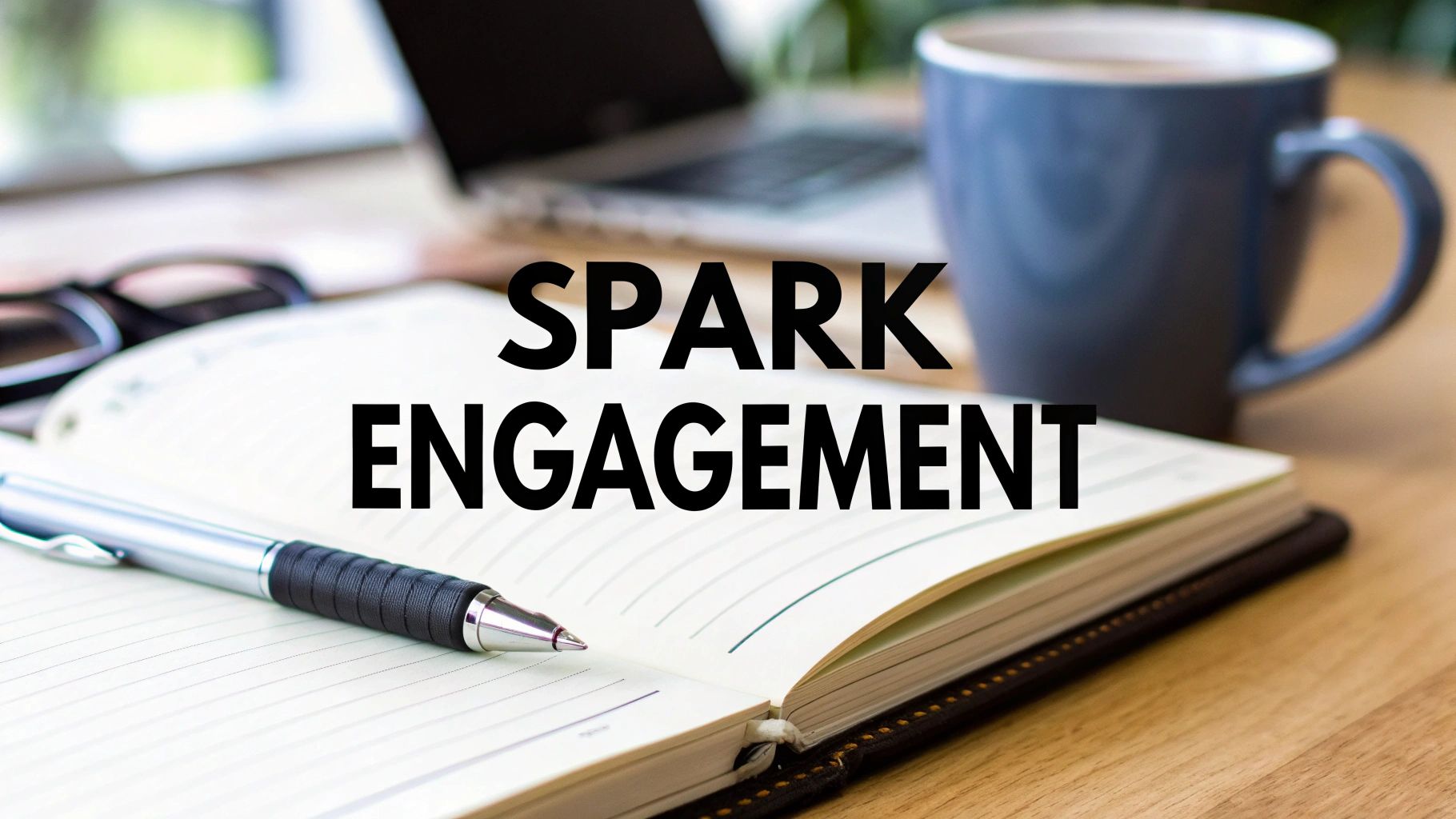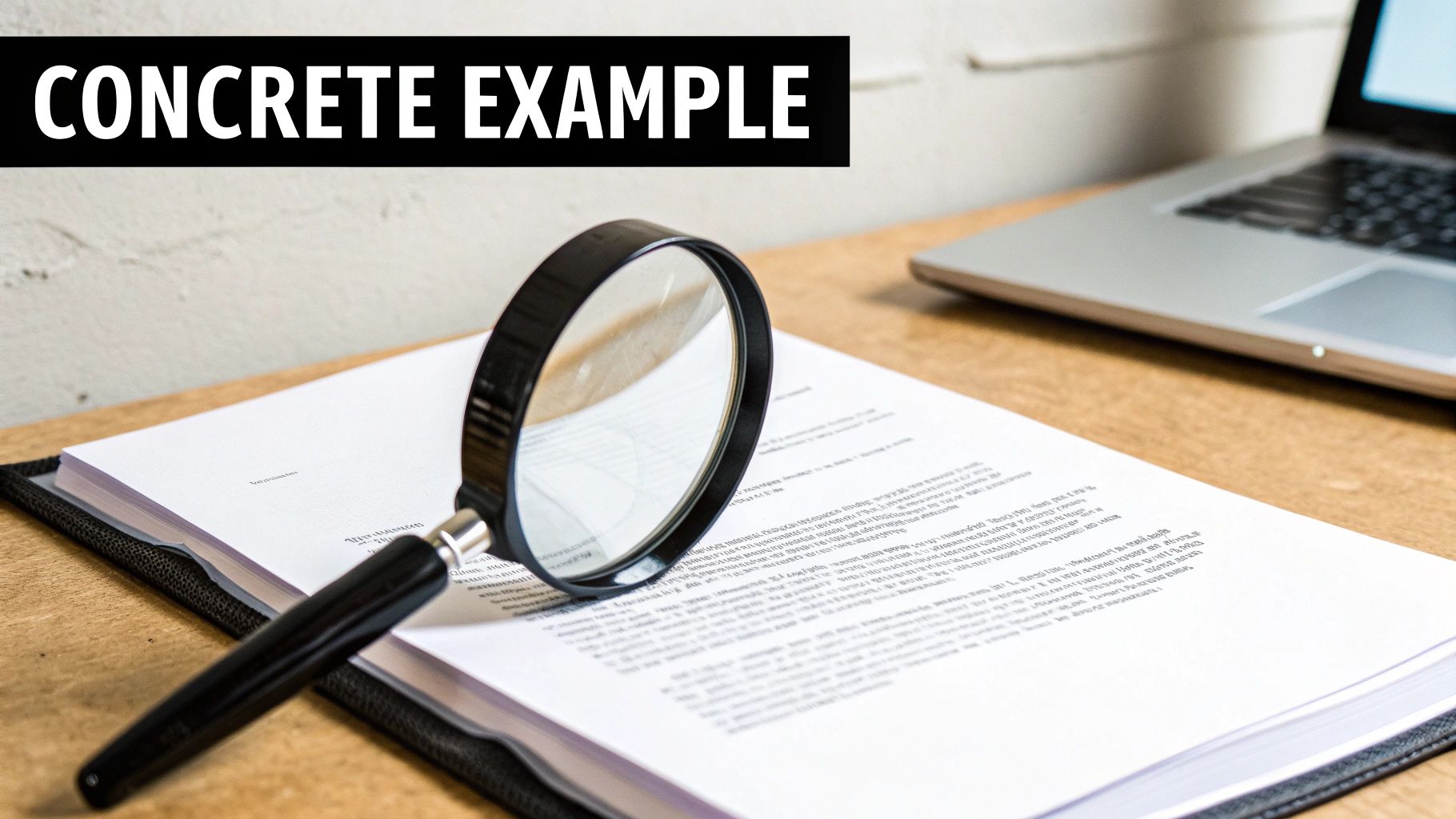
Top 8 Sentence Starters for Paragraphs to Engage Your Readers
Published on 2025-09-22
Effective sentence starters for paragraphs can transform dry text into compelling narratives. They help you grab attention, guide ideas, and leave a memorable impression. Whether you’re drafting a LinkedIn update or a business blog, the right opener can set the tone and invite readers to stay.
This listicle presents 8 categories of sentence starters, each tailored to a specific writing need. You’ll find additive cues like “Furthermore,” contrastive tokens such as “Conversely,” and causal phrases like “As a result.” We also cover sequential markers, concessive notes, exemplification, authority-based leads, and closing starters.
LinkedIn content creators, social media managers, marketing professionals, entrepreneurs, small business owners, founders and CEOs all face the same challenge: keeping readers hooked. Consistent, clear paragraph openings and transitions boost credibility and make your message easy to follow. That saves time and drives engagement.
Implement these starters to:
- Capture attention on busy feeds
- Smoothly link data points and ideas
- Back up claims with authoritative leads
- Wrap up arguments with memorable closes
This list goes beyond generic advice. Each starter comes with a quick example or scenario so you can apply it immediately. For extra tips on creating posts that resonate with your audience, check out how to write engaging posts.
Will you skip over weak paragraph openings? Scroll down to explore actionable sentence starters for introductions, transitions and conclusions. A few strategic words can make your writing stand out and keep readers reading to the end.
1. In addition to / Furthermore / Moreover
When you need to build a compelling argument, layering your points is crucial. Sentence starters like "In addition to," "Furthermore," and "Moreover" are your best tools for the job. These are additive transitions, signaling to your reader that you are about to provide more evidence, a new example, or a complementary piece of information that reinforces what you've just said. They create a smooth, logical flow, making your argument stronger with each paragraph.

Using these phrases effectively shows your audience that your ideas are well-supported and interconnected, rather than a collection of random points.
When to Use These Starters
This category of sentence starters for paragraphs is most effective when you are expanding on a previously stated idea. Use them to introduce a paragraph that adds weight to your claim.
- Academic Essays: When presenting multiple pieces of research to support a thesis statement.
- Business Reports: When listing several data points that lead to a single conclusion. For example, after showing a drop in sales, you might use "Furthermore" to introduce data on declining customer satisfaction.
- Persuasive Articles: When layering arguments to convince a reader. After making an emotional appeal, you could use "Moreover" to add a logical reason.
Actionable Tips for Implementation
To get the most out of these powerful transitions, follow a few simple guidelines. These tips will help you maintain reader engagement and avoid common pitfalls.
- Vary Your Choices: Avoid using the same starter repeatedly. Cycle between "In addition to," "Furthermore," and "Moreover" to keep your writing fresh and dynamic. This prevents your content from sounding robotic.
- Ensure Genuine Addition: Only use these starters when you are truly adding new, supportive information. If the new paragraph merely rephrases the previous one, the transition feels weak and unnecessary. Your goal is to build, not just repeat.
- Follow with Concrete Evidence: A strong additive transition should be followed by a strong piece of support. Back up your opening with specific data, a clear example, an expert quote, or a detailed explanation.
By using these starters thoughtfully, you can guide your reader through a well-structured and convincing argument. For a deeper dive into similar transitional phrases, you can find more examples of sentence starters on our blog.
2. On the other hand / However / Conversely
When you want to acknowledge complexity or introduce a counterpoint, contrastive sentence starters help you shift gears smoothly. Starters like “On the other hand,” “However,” and “Conversely” signal to your reader that you are about to present an opposing viewpoint or alternative perspective. These are contrast transitions, showing you respect differing opinions while strengthening your own argument’s nuance. By weaving in these phrases, you demonstrate balanced discourse and credibility in your writing. For more guidance on sentence starters for paragraphs, visit our blog at https://www.outrank.so.

When to Use These Starters
Use contrastive starters when you need to:
- Present counterarguments in debate essays, showing you’ve considered other positions.
- Discuss conflicting findings in research papers, for instance when one study contradicts another.
- Acknowledge criticism in opinion pieces, making your stance stronger by addressing dissent.
- Balance marketing claims in business reports, like highlighting both successes and challenges.
- Clarify trade-offs in social media posts, for example on LinkedIn, to show you’ve thought beyond a single viewpoint.
Actionable Tips for Implementation
- Start strong with However
- Place “However” at the beginning of a new paragraph for maximum impact.
- Follow with a concise explanation
- Immediately explain the opposing view in one or two sentences.
- Keep the contrast relevant
- Only introduce an alternative if it truly challenges or refines your previous point.
- Link back to your thesis
- After presenting the counterpoint, tie it back to your main argument to maintain cohesion.
- Mix with additives
- Combine contrastive starters with additive phrases later, such as “Nevertheless” or “Still,” to guide readers through your reasoning.
By mastering “On the other hand,” “However,” and “Conversely,” you create well-rounded content that resonates with LinkedIn content creators, marketers, and business leaders. These starters help you handle objections, show depth, and maintain reader trust in your next paragraph.
3. For example / For instance / To illustrate
Making an abstract claim or a general statement is one thing, but proving it is another. Sentence starters like "For example," "For instance," and "To illustrate" are essential for bridging the gap between theory and reality. These are exemplification transitions, signaling that you are about to provide concrete evidence, a specific case, or a clear illustration to make your point more tangible and understandable. They transform a broad idea into something the reader can easily grasp.

Using these phrases effectively demonstrates that your claims are not just empty words but are grounded in real-world proof, making your arguments more credible and relatable.
When to Use These Starters
This category of sentence starters for paragraphs is perfect for when you need to substantiate a general claim you've just made. Use them to introduce a paragraph that provides specific, supportive proof.
- Educational Content: When explaining a complex theory, you might say, "To illustrate," before providing a simple, real-world application of the concept.
- Business Writing: After stating that a new marketing strategy increased engagement, you could start the next paragraph with, "For example, our Instagram story views doubled within the first week."
- Scientific Papers: When presenting a finding, use "For instance" to introduce a specific research study or data set that confirms the discovery.
Actionable Tips for Implementation
To make your examples as powerful as possible, follow a few key guidelines. These tips will ensure your illustrations resonate with your audience and strengthen your core message.
- Ensure Clear Relevance: Your example must directly and obviously support the point you just made. A confusing or loosely related example can do more harm than good, distracting the reader and weakening your argument.
- Vary Your Example Types: Don't rely solely on one kind of proof. Mix it up by using statistics, expert quotes, brief anecdotes, or case studies. This variety keeps your content engaging and appeals to different reader preferences.
- Keep It Concise and Current: An effective example is sharp and to the point. Avoid long, rambling stories that bury the main takeaway. Also, use current and relevant examples that your target audience will recognize and connect with.
By grounding your statements with clear examples, you make your content more persuasive and memorable. To see how powerful this can be in a business context, explore these business storytelling examples for more inspiration.
4. As a result / Consequently / Therefore
When you need to connect an action to its outcome, these causal sentence starters are essential. Phrases like "As a result," "Consequently," and "Therefore" create a clear bridge between cause and effect, showing your reader the logical progression of your ideas. These are conclusive transitions, signaling that what follows is a direct outcome of the information you just provided. They are crucial for building logical arguments and demonstrating the implications of your points.

Using these starters correctly helps your audience follow a chain of reasoning, making your conclusions feel earned and inevitable rather than sudden or unsupported.
When to Use These Starters
This category of sentence starters for paragraphs shines when you need to draw a conclusion or show the direct consequences of a previously mentioned fact, event, or action. Use them to introduce a paragraph that explains an outcome.
- Scientific Reports: To explain the outcome of an experiment after detailing the methodology. For instance, after describing a chemical reaction, a paragraph might begin, "As a result, the compound changed color."
- Policy Papers: To connect a specific action or policy with its real-world results. For example, after outlining new regulations, you could start the next paragraph with, "Consequently, there was a measurable decrease in pollution levels."
- Historical Analyses: When linking a significant event to its subsequent impact on society. A paragraph discussing the aftermath of a treaty might start with, "Therefore, new trade routes were established between the nations."
Actionable Tips for Implementation
To use these logical connectors effectively, ensure your cause-and-effect relationship is clear and well-supported. These tips will help you create a powerful and logical narrative flow.
- Ensure a Genuine Causal Link: The most common mistake is using these starters when there isn't a true cause-and-effect relationship. The paragraph that follows must be a direct consequence of what came before. If the connection is weak, your argument will lose credibility.
- Use 'Therefore' for Strong Conclusions: While "As a result" and "Consequently" are excellent for showing outcomes, "Therefore" signals a more formal, logical deduction. Reserve it for moments when you are drawing your most important conclusions, especially after presenting extensive evidence.
- Support Your Causal Claim: A strong transition needs strong support. After stating "As a result," immediately provide the evidence that proves the outcome. This could be data, a specific example, or a direct quote that validates the connection you've made.
By carefully using these starters, you can guide your reader to the same logical conclusions you've reached. To elevate your professional communication further, you can find more insights in our guide to essential business writing tips.
5. First / Second / Finally (Sequential Starters)
When you need to guide your reader through a process, a series of arguments, or a multi-part explanation, sequential sentence starters are your most reliable allies. Phrases like "First," "Second," and "Finally" act as signposts, creating a clear and logical path through your information. These are sequential transitions, providing a roadmap that helps readers follow complex ideas without getting lost. They impose order and structure, making your content easy to digest and remember.
Using these organizational sentence starters for paragraphs signals a systematic presentation. This tells your audience that your points are deliberate and arranged in a meaningful sequence, which boosts your credibility and the clarity of your message.
When to Use These Starters
This category of sentence starters is essential for any content that presents information in a step-by-step or prioritized manner. Use them to introduce each distinct paragraph in a sequence.
- How-To Guides and Tutorials: When breaking down instructions into a clear series of actions. For example, "First, gather your materials. Second, assemble the base."
- Academic Essays: When presenting a series of arguments to support a thesis. Each paragraph can tackle a distinct point in a logical order.
- Business Presentations: When outlining a multi-stage plan or reporting on a sequence of events. For instance, outlining the steps of a new marketing strategy.
Actionable Tips for Implementation
To use these sequential starters effectively, it's important to be intentional and consistent. These tips will help you create a clear, coherent flow for your readers.
- Plan Your Sequence: Before you start writing, outline the complete order of your points. Know what comes first, second, third, and last. This ensures your sequence is logical and complete, preventing you from having to rearrange paragraphs later.
- Maintain Parallel Structure: For maximum clarity and impact, try to keep the structure of each sequential paragraph similar. For example, if your "First" paragraph starts with a claim followed by evidence, your "Second" paragraph should follow the same pattern.
- Consider Alternatives: Don't feel locked into "First, Second, Third." Vary your language with alternatives like "Initially," "Next," "Subsequently," and "Ultimately" or "To begin with," "Furthermore," and "In conclusion" to make your writing more sophisticated and engaging.
6. Despite / Although / While
Addressing counterarguments is a hallmark of sophisticated and persuasive writing. Sentence starters like "Despite," "Although," and "While" allow you to do just that. These are concessive transitions, signaling to your reader that you are about to acknowledge a point that might seem to contradict your main argument. Using them demonstrates that you have considered multiple perspectives, which strengthens your credibility and makes your own position more convincing.
These phrases create a nuanced and balanced discussion. Instead of ignoring potential objections, you bring them into the open and show why your primary point still stands, making your argument more robust and well-rounded.
When to Use These Starters
This category of sentence starters for paragraphs is ideal when you need to preemptively address reader skepticism or acknowledge the complexity of a topic. Use them to introduce a paragraph that concedes a minor point in order to strengthen a major one.
- Opinion Pieces: When recognizing a valid counterpoint before refuting it or explaining why your perspective is stronger. For example, "Although some critics argue that the new policy is costly..."
- Research Papers: When acknowledging the limitations of a study without invalidating its findings. For instance, "Despite the small sample size, the results indicate a clear trend..."
- Business Proposals: When addressing potential risks or drawbacks of a proposed plan while emphasizing the overriding benefits. For example, "While the initial investment is significant, the long-term ROI is projected to be substantial."
Actionable Tips for Implementation
To use these concessive starters effectively, you need to strike a careful balance. These tips will help you acknowledge other viewpoints without weakening your own.
- Be Genuine in Your Concession: Don't use these starters to introduce a weak or misrepresented version of an opposing view (a "straw man" argument). Acknowledge the counterpoint fairly and accurately. This builds trust with your audience.
- Pivot Back to Your Main Point: The concession should always be followed by a strong pivot back to your primary argument. Use words like "however," "still," or "nevertheless" to transition back. For example, "Despite these challenges, the project remains the most viable option because..."
- Keep the Concession Brief: The purpose is to acknowledge, not to dwell. State the opposing point concisely in the first part of your sentence or paragraph, then dedicate the majority of the space to reinforcing your own argument with evidence and analysis.
By strategically using these sentence starters for paragraphs, you show your reader that you are a thoughtful, well-informed writer, making them more likely to trust your ultimate conclusion.
7. In conclusion / To summarize / Ultimately
When it's time to wrap up your argument and leave a lasting impression, conclusive sentence starters are essential. Phrases like "In conclusion," "To summarize," and "Ultimately" act as powerful signposts, telling your reader that you are about to synthesize the information and deliver your final verdict. These are conclusive transitions, designed to provide closure and reinforce your main message. They signal a shift from presenting evidence to interpreting its overall meaning.
Using these phrases effectively provides a satisfying end to your discussion. It ensures your audience walks away with a clear understanding of your key takeaways and the significance of your argument.
When to Use These Starters
This category of sentence starters for paragraphs is reserved for the final moments of a document, a major section, or a presentation. Use them to signal that no new information will be introduced and that you are now focused on summarizing and concluding.
- Academic Essays: To begin the concluding paragraph that restates the thesis and summarizes the main supporting points.
- Business Reports: To introduce the executive summary or final section that condenses key findings and offers final recommendations.
- Persuasive Articles: To deliver the final call to action or concluding thought after all evidence has been presented. For instance, after detailing environmental impacts, you might use "Ultimately" to state the necessary course of action.
Actionable Tips for Implementation
To make your conclusions powerful and memorable, deploy these starters with care and strategy. These tips will help you avoid weak endings and ensure your final words resonate.
- Avoid Redundancy: These phrases explicitly state that you are concluding. Therefore, avoid following them with cliché statements like "As I have shown." Instead, dive directly into your powerful summary or final thought.
- Reserve for True Endings: Do not use these starters in the middle of your body paragraphs. Doing so can confuse the reader, making them think you're finishing your argument prematurely. Only use them for an actual conclusion of a section or the entire piece.
- Deliver a Strong Final Point: Your concluding sentence starter creates an expectation for a powerful takeaway. Follow it up with a concise synthesis of your argument, a thought-provoking final statement, or a clear call to action. This is your last chance to make an impact.
By using these conclusive starters correctly, you can guide your reader to a clear and impactful finish, ensuring your core message is understood and remembered. For more ways to structure compelling arguments, you can find additional sentence starters on our blog.
8. According to / Research shows / Studies indicate
When your goal is to build an argument that is not just persuasive but also authoritative, you need to anchor your claims in evidence. Sentence starters like "According to," "Research shows," and "Studies indicate" are essential for this purpose. These are authority-based transitions, signaling to your reader that you are about to introduce credible sources, expert opinions, or empirical data to back up your statements.
Using these phrases builds trust and establishes your credibility. Instead of asking your audience to simply take your word for it, you are demonstrating that your position is supported by recognized experts or verifiable facts. This makes your writing more convincing and your arguments significantly harder to dismiss.
When to Use These Starters
This category of sentence starters for paragraphs is most powerful when you need to introduce external evidence to substantiate a claim you have made. Use them to begin a paragraph that provides factual support, lending weight and validity to your argument.
- Academic and Professional Writing: When citing peer-reviewed journals, official reports, or established academic theories. For example, "Studies indicate a direct correlation between employee engagement and productivity."
- Content Marketing and Blog Posts: When referencing industry reports, market research, or expert interviews to add authority to your content. A tech blog might start with, "According to a recent Gartner report, AI integration is the top priority for CIOs."
- Journalism and Reporting: When quoting sources, presenting statistical data, or summarizing the findings of an investigation to ensure objectivity and accuracy.
Actionable Tips for Implementation
To use these authority-based starters effectively, it's important to handle your sources with care. These tips will help you integrate evidence seamlessly and maintain your credibility.
- Cite Specific and Credible Sources: Always follow up the starter with a clear attribution. Instead of a vague "Studies show," write "A 2023 study from Stanford University shows..." Specificity makes your evidence verifiable and more impactful.
- Vary Your Attribution: Repetitively using "According to" can sound monotonous. Mix it up with phrases like "Research from [Source] reveals," "[Expert's Name], a leading expert in the field, explains," or "Data from the [Institution] indicates..."
- Ensure Relevance and Currency: The evidence you cite must be directly relevant to your point and, depending on the topic, reasonably current. Using outdated statistics or irrelevant studies can undermine your argument rather than support it.
By strategically using these sentence starters for paragraphs, you ground your writing in a foundation of facts and expertise, transforming your personal opinions into well-supported, authoritative statements.
Sentence Starter Types Comparison Table
| Sentence Starter Group | Implementation Complexity 🔄 | Resource Requirements ⚡ | Expected Outcomes 📊 | Ideal Use Cases 💡 | Key Advantages ⭐ |
|---|---|---|---|---|---|
| In addition / Furthermore / Moreover | Low | Low | Strengthened argument flow | Academic essays, business reports, persuasive text | Easy to use, versatile, supports logical flow |
| On the other hand / However / Conversely | Medium | Medium | Balanced, nuanced arguments | Debates, research papers, opinion pieces | Demonstrates critical thinking, shows balance |
| For example / For instance / To illustrate | Low | Medium | Clarified, engaging evidence | Scientific papers, business cases, educational content | Makes abstract tangible, increases engagement |
| As a result / Consequently / Therefore | Medium | Medium | Clear cause-effect reasoning | Scientific reports, policy papers, historical analyses | Clarifies logic, creates compelling conclusions |
| First / Second / Finally (Sequential) | Low | Low | Clear structure and roadmap | How-to guides, academic essays, business presentations | Highly organized, easy to follow |
| Despite / Although / While (Concessive) | Medium | Medium | Nuanced, credible arguments | Research papers, opinion pieces, policy arguments | Shows intellectual honesty, handles complexity |
| In conclusion / To summarize / Ultimately | Low | Low | Effective summaries & closure | Academic conclusions, business reports, essays | Provides clear ending, emphasizes takeaways |
| According to / Research shows / Studies indicate | Medium | High | Increased credibility | Academic papers, journalism, policy documents | Establishes authority, objective support |
How to Implement These Starters Today
You now have a comprehensive toolkit filled with powerful sentence starters for paragraphs, designed to bring clarity, flow, and structure to your writing. We’ve moved beyond a simple list of words and explored the strategic intent behind each category, from building upon ideas with "In addition to" to introducing counterpoints with "On the other hand" and proving claims with "For example."
The true value of these starters lies not in memorizing them, but in understanding their function. They are the signals that guide your reader through your argument, making your content easier to follow and far more persuasive. Think of them as the essential connective tissue that transforms a collection of standalone ideas into a cohesive, compelling narrative.
From Knowledge to Action: Your Next Steps
Knowing these phrases is one thing; mastering them is another. The bridge between the two is intentional practice. To start implementing these sentence starters for paragraphs effectively and see a tangible improvement in your writing, follow this simple, actionable plan.
Choose Your Focus: Don't try to master all eight categories at once. Pick one or two to focus on this week. If your writing often feels like a list of disconnected facts, start with transitional starters like "As a result" or "Consequently." If you struggle to back up your claims, concentrate on evidence-based starters like "According to" or "To illustrate."
The 10-Minute Writing Sprint: Set a timer for just 10 minutes. Choose a topic you know well, perhaps a recent industry trend or a core business principle. Your goal is to write a few short paragraphs, intentionally using your chosen sentence starters. This low-pressure exercise builds muscle memory without the stress of a "real" assignment.
Review and Refine: Look back at your writing sprint content. Did the sentence starter create the logical connection you intended? Could a different one be more precise? For instance, was "Furthermore" a better choice than a simple "In addition to"? This active self-editing process is where deep learning happens.
Analyze Content You Admire: The next time you read a compelling article or blog post, pay close attention to how the author begins their paragraphs. Highlight or make a note of the sentence starters they use. Deconstructing the work of writers you respect is an incredibly effective way to see these principles in action and expand your own creative palette.
The Broader Impact on Your Professional Voice
Mastering these foundational elements of writing does more than just improve your paragraphs; it elevates your entire professional presence. Whether you are drafting a crucial email to a stakeholder, updating your team on a project, or building your brand online, clarity is currency. For those specifically looking to apply these principles to professional networking, delve deeper into strategies for writing LinkedIn posts that truly engage your audience. The ability to structure your thoughts clearly and guide your audience logically is a hallmark of an expert and a leader.
Ultimately, these sentence starters for paragraphs are your tools for building influence. They empower you to articulate your ideas with confidence, ensuring your message is not just seen, but understood, respected, and remembered. Start small, practice consistently, and watch as your ability to communicate with impact transforms.
Ready to move beyond starters and generate entire drafts that capture your unique voice? Discover how autoghostwriter can help you brainstorm ideas, create structured content, and repurpose your best thoughts into compelling articles and posts in minutes. Visit autoghostwriter to see how AI can become your ultimate writing partner.